First drive: 2019 Porsche 911 Carrera 4S Cabriolet in Greece
Open-topped cars have been an integral part of Porsche’s DNA ever since the first 356 burst onto the scene back in 1948. Porsche ditched fully open cars and went down the Targa route in the early 1960s due to US safety regulations, but the ragtop format was reprised with the debut of the first 911 Cabriolet at the 1982 Geneva Motor Show.
Since then, the 911 Cabrio has had an uninterrupted production run, even though Porsche’s line-up includes two other alfresco models in the form of the 718 Boxster and 911 Targa (albeit the previous-gen 991 for now). The 911 Cabriolet lineage now carries forward with the launch of the 992 generation, which follows closely in the wheeltracks of the recently unleashed hardtop.
The all-new convertible carries over the core elements of the 992 coupe, but its obvious point of differentiation is a well-integrated canvas roof that’s deployed and retracted by a lightweight magnesium electrohydraulic folding mechanism that gets the job done in just 12 seconds.
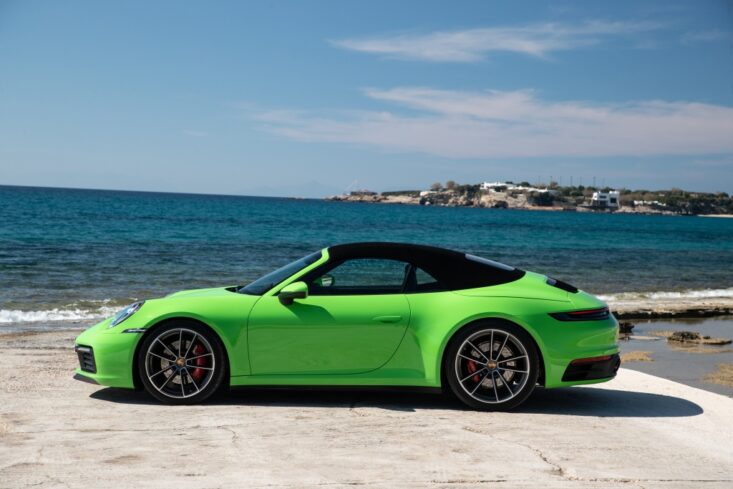
Soft-top variants of coupes often fail to reflect the rakish profile of their hard-top counterparts, and some end up looking plain ill-resolved. Happily, that’s not the case here, as the 911’s canvas roof (when extended) blends harmoniously with the rear fenders and engine cover. It’s one of the best executions yet of how to maintain design purity in a car that’s had its roof lopped off.
If you’ve got your ear close to the ground, you’ll be aware the 992-gen 911 has been engineered to accept a hybrid powertrain, necessitating an overall dimensional increase. As a result, the 992 Carrera stretches 4519mm from bumper to bumper (28mm longer than the oldie) and 1852mm wide (+44mm). Unlike before, it doesn’t matter whether they’re RWD or AWD, they’re now all the same width.
Apart from satisfying the latest packaging parameters, the broader, lengthier footprint also helps from a visual perspective, endowing the 992 Cabrio with more GT-like proportions than its predecessors. That said, it’s still unmistakably a 911.
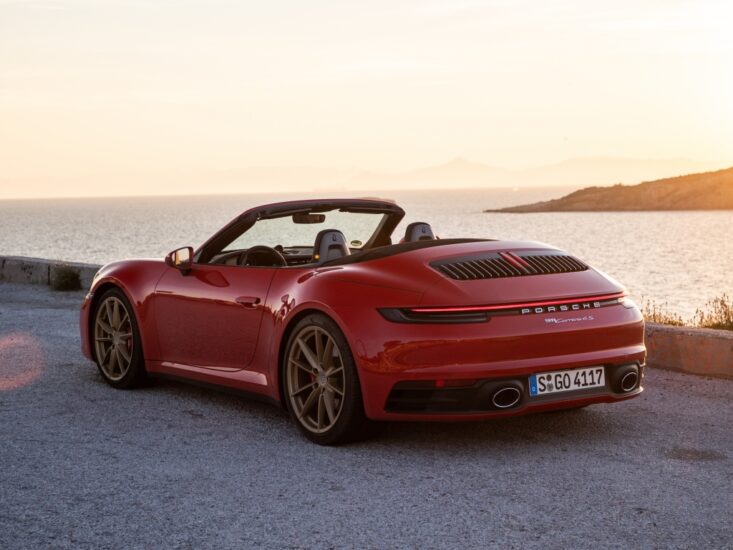
The crayon wielders in Stuttgart have attempted to provide some clear visual links in the 992 with yesteryear 911s, and among these are the vertical grille slats atop the engine cover (black in RWD models and silver in the Carrera 4/Carrera 4S). The front bonnet now tapers more inward towards the front, which also is a nod to early 911s. Meanwhile, the full-length light bar that runs across the rump of the car harks back to the 964 and 993 generations of the 1990s.
The entire bodyshell is now fabricated from aluminium (apart from the front and rear fascias), which has prevented the 911’s weight from bloating out in its new larger form. The drop-top carries a 70 kg weight penalty over its coupe brother but it’s still no barge at a lithe 1585 kg for the Carrera S Cabriolet (1635kg for the Carrera 4S Cabrio).
August Achleitner, the man in charge of the 911 and 718 model lines, says the Cabrio gains slightly stiffer springs than its coupe counterpart, along with recalibrated dampers, to offset its extra mass. He says the latest ragtop is torsionally stiffer than its predecessor but concedes it’s only a third as rigid as the 992 coupe. That’s pretty much par for the course when you sacrifice the structural integrity provided by a fixed roof.
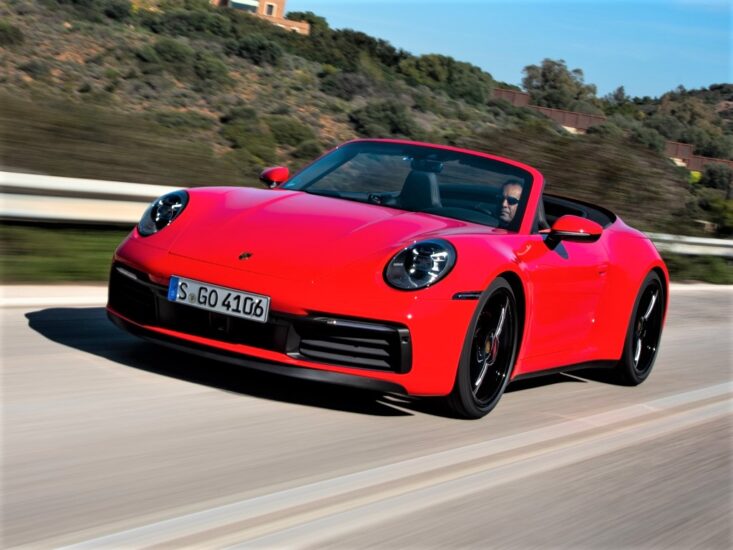
But does this comparative loss of structural integrity dampen the fun factor? That’s what we’re here – on the mountainous roads of Attica, in Greece – to find out.
We’ve been assigned a silver Carrera S (later on I very briefly nab a red Carrera 4S for photography), and as we trundle away from our overnight digs, first impressions are of how docile and aurally subdued the 3.0-litre flat-six motor seems. It might generate robust outputs of 450 hp and 530 Nm, but at low to middling revs – and with ‘Normal’ selected via the rotary drive knob on the steering wheel – the six-pot sounds relatively uninspiring, chuntering out a flat drone from its pair of large oval tailpipes. This is the quiet before the storm, but I’ll get to that shortly…
The new eight-speed PDK dual-clutch auto is hard to fault. In ‘Normal’ mode it shifts up early and seamlessly when trundling around town, which means the 911 Cabrio is no more taxing to drive than a VW Golf around town. Of course, rearward visibility is slightly compromised, but it’s a realistic daily driver in every sense. Wind and road noise, too, are well suppressed with the roof up, and buffeting levels aren’t too bad at an 80-100 kph cruise with the top down (the electrically extendable wind deflector helps).
The only bugbear is ride quality that’s on the rugged end of the scale – even in ‘Normal’ mode, which is as cosseting as it gets in this car. It’s not jarring enough to shake your teeth fillings loose, but you still end up subconsciously bracing your torso as you spot a patchy section of tarmac – of which there’s plenty in Greece – looming ahead.
I’ve yet to drive the 992-gen 911 coupe, so I don’t know how its ride compares, but I’m guessing the drop-top’s firmness may be partly down to its beefier spring rates and recalibrated damper settings. The Cabrio’s chassis may have lost around two-thirds of its torsional rigidity vis-à-vis the hardtop, but traces of scuttle shake are only noticeable as you bounce across a particularly poor section of tarmac where either the left or right front wheel encounters a pothole or bump, causing the car to flex laterally.
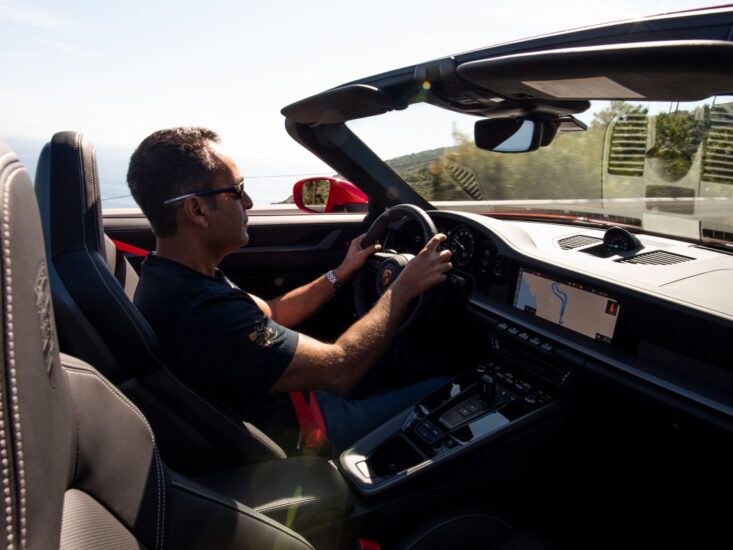
But where our morning drive leg was across predominantly lumpy and slippery roads (due to an oddly greasy surface), the post-lunch route is an absolute cracker. Smooth, grippy and comprising a breathtaking succession of slow and fast corners, it’s a fitting arena to unleash the 911’s inner beast – and it’s a ferocious one, at that.
The 3.0-litre flat-six turbo that seemed bland around town reveals an entirely different character when you give it the beans in Sport and Sport+ modes. The engine note takes on a hard-edged growl and there’s a chorus of fizzing, crackling and popping to liven up the show. But the best part is the wastegate whistle when you back off the gas – reminiscent of a Group B rally car.
A 0-100 kph split of 3.9 seconds (3.7 seconds with the optional Sport Chrono package) and top whack of 306 klicks for the Carrera S Cabrio tell part of the story, but it’s the massive 530 Newtons of twist – on tap from 2,300 rpm all the way up to 5,000 rpm – that’s the real headline-grabber. There’s bags of grunt to slingshot you out of slow corners, which means you can hang on to a higher gear than might have seemed appropriate and use that fat mid-range to do the work.
After a furious 30-minute thrash, it’s evident the 911 Cabriolet has enough tautness and precision in its demeanour to make it an entertaining device even for spirited drivers. Drop-tops often get a dud rap for being pansies in terms of chassis dynamics, but this Teuton – and the Audi R8 V10 Spyder – are proof that this isn’t always the case. Granted, if regular track days are on the menu, then go with the coupe, otherwise the Cabriolet is up to the task. The other benefit of having no solid lid above your noggin is that you get to savour the full vocal delights of the flat-six motor when going at it hammer and tongs.
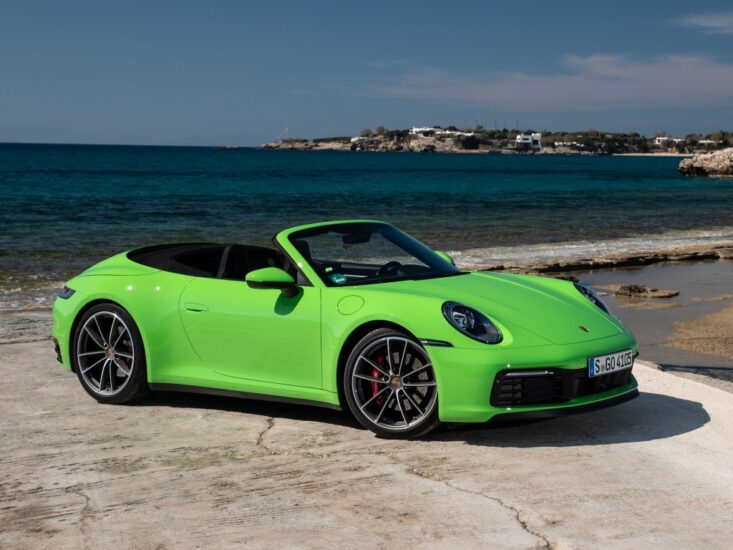
The 992-gen 911’s cabin makes a big step forward – and, in a sense, rearward – from its predecessor. The dashboard is distinguished by flat rectangular surfaces, just like early 911s, and there’s a minimalist theme that also mirrors the simplicity of its ancestors. A large analogue tacho (with a real needle) takes centre stage, and it’s flanked by virtual dials on either side. Integrated into the dash above the centre console is a 10.9-inch screen for Porsche Communication Management (PCM), which encompasses all the infotainment functions. It’s crystal-clear and more or less fool-proof.
There’s really not a whole lot wrong with the overall cabin layout, although I’m not sold on the toggle-switch transmission lever, which feels out of place in a 911. In a Panamera, Macan or Cayenne, no problem, but for the brand’s core sports car I’d rather see a proper lever that feels connected to mechanical bits than a device that has all the emotion of flicking a light switch.
All in all, though, the latest 911 Cabriolet is a compelling package that successfully bridges the gap between relaxed open-top cruiser and finely honed sportscar. It’s likely to please both boulevard-trawling posers and hard-charging steerers in equal measure.
Photos by Porsche.










There are no comments. Be the first!